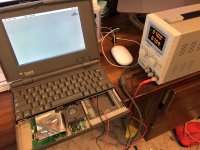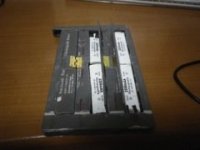Well, with 6 x AAA NiMh batteries, which I incorrectly described in my previous post as Ni-Cad,
the battery works perfectly. So 5 x AAA NiMh batteries simply couldn't provide a high enough voltage under load. With no load the voltage of this pack of 6 cells is 8V which is a tad high, however as we now know that's irrelevant because the voltage drops under load. Once the powerbook has started up the voltage of the 6 cells in series settles at 6.6V. It ranges between 6.4V and 6.6V depending on what you're doing with the Powerbook. So NiMh definitely works! If I just mount these battery holders in the hole I cut in the PB100 battery it'll be a usable daily driver. I still need to recap the display though so I won't use it extensively until I have done that.
It only occurred to me tonight, however, that because all these little 1.2v (nominal) 900mAh NiMh batteries are in series I had basically made one 7.2v (nominal) 900mAh NiMh Powerbook 100 battery. Oops! This compares extremely poorly to the original SLA battery which was 2.5Ah, and was also able to be charged by the Powerbook itself. I really should've just refilled, charged and desulfated the lead-acid batteries instead of hacking one open to install cells of a different chemistry. Even if they'd only regained half of their original capacity they would have been ahead of the dummy battery full of AAAs.
techknight suggests in another thread that this desulfation will probably have good results. Any thoughts
@techknight?
So my next project will be to refill and recover my other dead Powerbook 100 battery and see if it compares favourably with my hacked NiMh battery.
It's pretty clear that swapping out the SCSI drive for a SCSI2SD has reduced the power consumption of the Powerbook so either way it might not be too bad. Although when I metered the 6.4-6.6v 6 x AAA NiMh battery pack it was drawing more like 900mA than 700mA, so you would possibly get less than an hour out of this pack.
So apart from the plan to recover my other PB100 battery, as I have this dummy battery to play with for the moment I could try to improve it. I could squeeze in another six NiMh AAAs in order to create an 1800mAh battery pack but that is a lot of batteries to periodically remove and charge. Something else that only occurred to me tonight is that if I install several series pairs of 600mAh
3.6v 10440 lithium batteries (same form factor as AAA) in parallel then I could make better use of the space I've carved out of the battery. I could install 3 x pairs in parallel and produce an 1800mAh 7.2v Li-ion battery pack. This would mean I would only need to remove and charge six batteries, and I already have a universal four-channel Li-ion charger so this wouldn't be any more inconvenient.
It's possible that I could also try to build a charging circuit into the battery pack. There are plenty of Li-ion charging controller ICs you can buy for like $5. I suspect most of them are not designed to be used in a device which both draws from and charges its battery through the same two contacts but with a bit of research something could probably be done.



